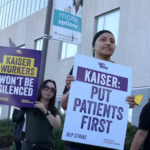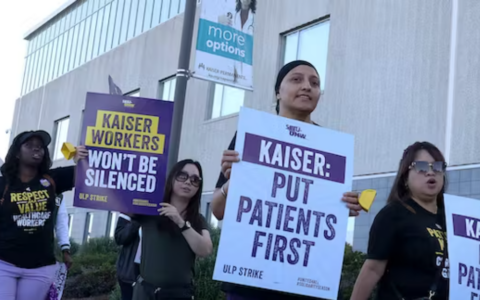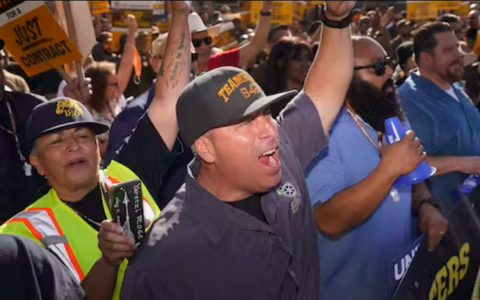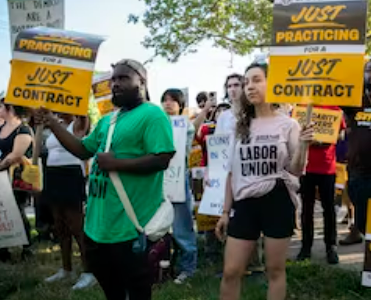Marick Masters, Professor of Business and Adjunct Professor of Political Science, Wayne State University
The United Auto Workers union, which represents nearly 150,000 employees of companies that manufacture U.S.-made vehicles, has been engaged since July 2023 in the labor negotiations it undergoes every four years with the three main unionized automakers.
By late August, it still wasn’t clear that the UAW would agree to a new contract with Ford, General Motors and Stellantis – the automaker that manufactures Chrysler and 13 other vehicle brands – by their impending deadline. The contracts expire at 11:59 p.m. Sept. 14.
The union’s leaders skipped the traditional handshake ceremonies it usually holds with these automakers, which are often called the Big Three or Detroit Three. The union instead held grassroots photo-ops: UAW leaders greeted rank-and-file members at one Ford, one GM and one Stellantis factory. On Aug. 25, the UAW announced that 97% of its members had authorized a strike “if the Big Three refuse to reach a fair deal.” It’s a major milestone.
I’m a labor scholar who has studied the history of UAW collective bargaining with the Detroit Three. Given that the UAW is making major demands at a time of rising union assertiveness and ambition, I believe it’s reasonable to wonder whether U.S. automakers will be the next industry to face a strike.
In 2023, there have been strikes by screenwriters, actors, health care workers and hotel staff, as well as vigorous organizing by workers for warehouse and delivery services at Amazon, UPS and FedEx.
Strike could stall Detroit GM, Ford and Stellantis
All three automakers with expiring contracts have amassed nearly US$250 billion in reported profits in their North American operations over the past decade.
And UAW leaders have pledged to garner what they see as their members’ fair share of those profits through higher wages and stronger job security.
The UAW’s newly elected president, Shawn Fain, frequently denounces corporate greed and has proclaimed the union’s willingness to go on strike. In the past, the union has held strikes against one automaker at a time, most recently in 2019 against GM.
That could change this time.
“The Big Three is our strike target,” Fain has said. “And whether or not there’s a strike, it’s up to Ford, General Motors and Stellantis.”
The UAW has said it has more than $825 million in its strike fund to help workers make do without pay should they walk off the job.

Fain’s leadership
Fain has declared that the union will no longer maintain the somewhat cozy relationship with the Big Three that led to major concessions in the past.
Many of the union’s other new leaders also are affiliated with the UAW’s Unite All Workers for Democracy caucus, which launched a successful campaign to require the direct election of the union’s top officials in 2022, with runoff elections held in 2023. They want to prevent a recurrence of a massive scandal that resulted in the federal prosecution of more than a dozen UAW leaders from 2017 to 2022.
Two former UAW international presidents were sentenced to time in prison after being convicted of embezzling union funds. The new slate of leaders assumed control of the UAW under court supervision in March 2023.
Seeking equal pay for EV workers
As part of their bolder strategy, the UAW’s new leaders have criticized the joint ventures between the three automakers and foreign-based electric battery producers.
They want to see Ford, GM and Stellantis paying UAW-level wages and benefits at all joint-venture operated plants in the U.S. making batteries for their EVs. Today, workers at the joint-venture factories earn far less than their counterparts who produce vehicles that run on fossil fuels.
The UAW has succeeded in organizing one of these joint ventures, Ultium Cells in Lordstown, Ohio. But pay for workers at the former General Motors plant, which is now a joint EV battery venture between GM and LG Energy, starts at just $16.50 per hour. In 2019, the year that GM ended car assembly at that factory, workers earned $32 per hour.
The UAW has several other objectives, which Fain first announced in a Facebook live meeting on Aug. 1, 2023.
They include greater job security and steep wage increases for UAW-represented workers covered by the union’s contracts with GM, Ford and Stellantis.
Among other things, it also seeks to end the two-tier wage system negotiated in 2007, under which new hires make much less than veteran workers, and the restoration of cost-of-living allowances, which the UAW also conceded in 2007 to help the companies stay afloat during the Great Recession.
Other UAW goals include resuming company-paid retiree health care benefits, adding more paid time off and limiting the use of temporary employees. Fain also says he wants workweeks scaled down to 32 hours, from its current 40.
Smaller ranks
Union membership in the auto manufacturing industry has shrunk from nearly 60% in 1983 to under 16% in 2022. Nonunion competitors with U.S. locations include foreign companies such as Toyota, Honda, BMW and Volkswagen, as well as domestic-based EV rivals Tesla and Rivian.
In 1970, GM employed more than 400,000 workers. In 2001, the Big Three combined employed 408,000. Today, a total of only 146,000 people work for those companies – 57,000 at Ford, 46,000 at GM and 43,OOO at Stellantis.
The Big Three’s share of the U.S. automotive market has declined to about 40% from more than 90% in the mid-1960s.
But the UAW’s negotiations also directly affect the economic livelihood of the millions who work for the Big Three’s suppliers and in communities dependent on the $1 trillion the auto industry contributes to the U.S. economy.
In addition, many union and nonunion employers monitor the wages and benefits of UAW-represented workforces as they set compensation for their own employees. When union members get raises and better benefits, many employers of nonunion autoworkers mirror those changes – raising pay too.
The shift to electric vehicles poses several related challenges to the UAW.
First, it requires less labor than producing vehicles that burn fossil fuels, which means EV manufacturing generates fewer jobs.
Second, autoworkers employed at joint-venture EV-battery factories have to be organized by the UAW on a case-by-case basis. That can prove especially difficult at plants located in such states as Kentucky, Tennessee or Georgia – where unions have lower membership rates.
Third, nonunion electric vehicle companies like Tesla and Rivian generally pay their production workers less than the Detroit Three.
What the automakers say
Ford, GM and Stellantis have noted that they have invested heavily in U.S.-based factories to preserve UAW-represented jobs. Also, the Big Three point out that they have shared their North American profits in sizable annual payments to their workers.
In 2022, for example, the Detroit Three combined made profit-sharing payments that averaged $36,686 per worker. In addition, the companies pay higher wages and provide more benefits to U.S. autoworkers than foreign automakers, such as Toyota and Honda, or domestic EV producers.
Ford CEO Jim Farley and GM President Mark Ruess have published op-eds in the Detroit Free Press praising their workers and expressing their commitments to do right by them.
“We share common goals” with the UAW, Farley wrote in late June. Both sides want to reach “a new deal that allows us to stay ahead of the changing industry landscape, protecting good-paying jobs in the U.S.”
But both executives have emphasized their need to be competitive.
After seeing the UAW’s demands, GM criticized their “breadth and scope” and said they “would threaten our ability to do what’s right for the long-term benefit of the team.” The automaker also reiterated its openness to what it called a “fair agreement” and to raise wages.
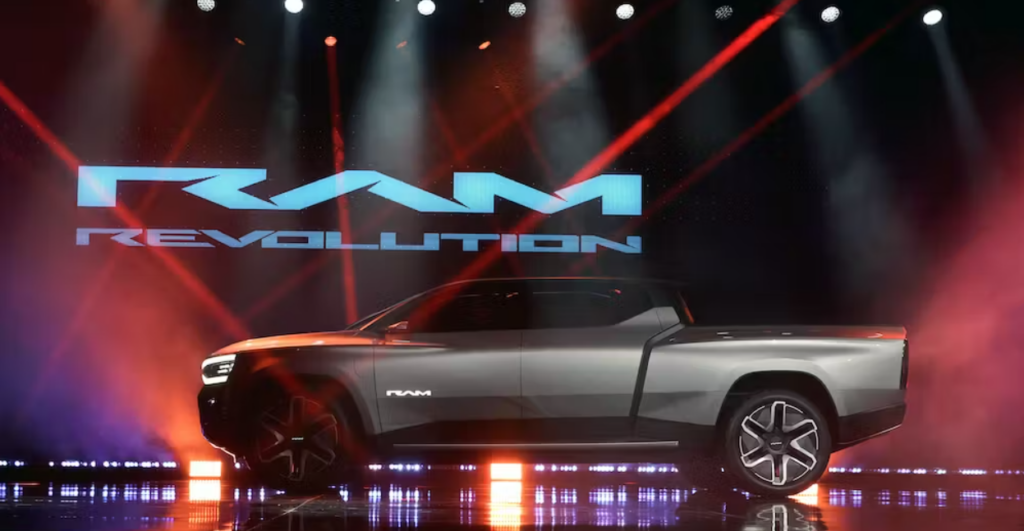
What may happen during a UAW strike
Halting production for even one big automaker during a strike would directly harm thousands of workers and cost the company money in terms of lost sales and production. Strikers would lose out on wages that would only be partially offset by the union’s striker benefits of $500 per week.
And any strike could further disrupt supply chains that have not fully recovered from the shocks caused by the COVID-19 pandemic and natural disasters that have sharply curtailed vehicle production since 2020.
Financial losses can be immense for automotive companies when their workers walk off the job. The 40-day strike in 2019 cost GM a reported $3.6 billion.
A weekslong strike would also jeopardize the UAW’s struggle to rebuild its image following a string of corruption scandals.
I believe that it’s up to both the corporate and labor leaders involved to avoid what could turn out to be a costly miscalculation.
This article was updated on Aug. 25, 2023, to report the strike vote.


